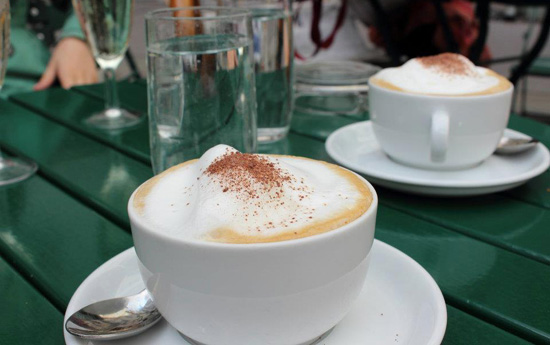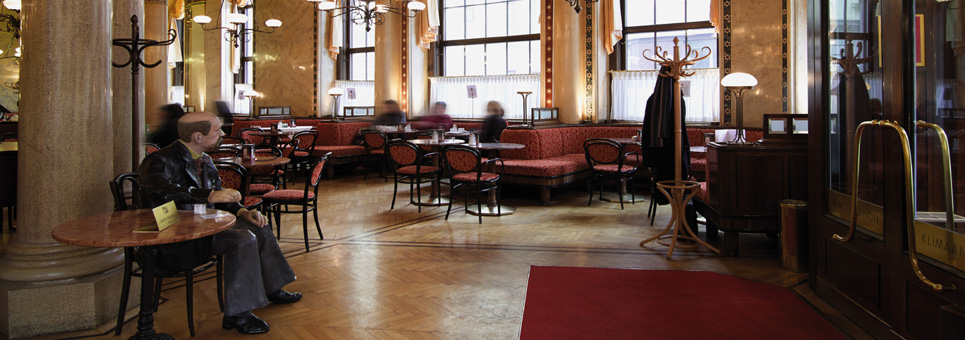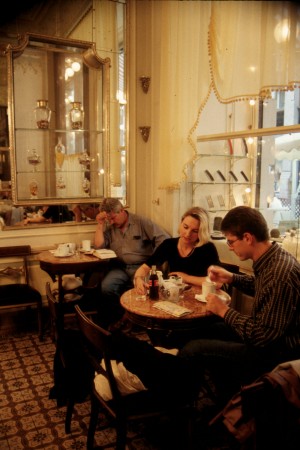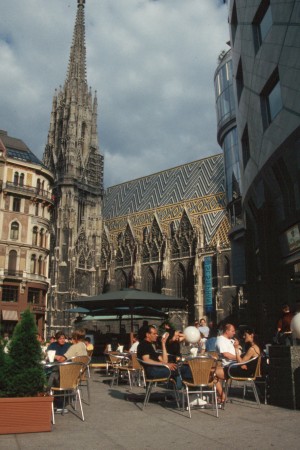

“I AM SIGMUND SPIELBERG!!!”
The obviously unemployable flaneur with umlaut eyes landed at my marble-topped table without a proper invite, brusquely pushing aside a Thonet wooden chair.
Brandishing a copy of Der Spiegel on a wooden rolling pin in his left hand, and reeking from an unfortunate cologne resembling turning fruit or female arousal or even Cutter, Sigmund sighed, coughing up and swallowing a leech-like phlegm ball.
“Wow!” I breathed in speedy disbelief. “Any relation to the American filmmaker Steven Spielberg?!”
“Why yes!” “Siggy” fogged up his Rayban aviator sunglasses and polished the lenses on a starched white napkin, smiling like a demon out of Hieronymous Bosch. “Steven Spielberg is a distant cousin of mine. . . .”
We were at the legendary Grand Café (a classic Fin de Siecle “grand café”), where reservations are suggested: (00 43 1-580 9120), and which is perhaps Vienna’s most storied meeting place. Easily located right on the first floor of the Grand Hotel Wien (9 Kaertnerstrasse) on Vienna’s romantic Ringstrasse, this atmospheric kaffehaus (coffeehouse) resembled any Danté-like circle of hell, with dark exhaust-spewing Mercedes-Benzes prowling around outside on the famous circular road like canny reef sharks, just waiting to take you on a “luxus” ride into the other side of night.
However, inside with its vaulted ceilings, marble pillars, wooden hatracks, bentwood chairs and foreign periodicals on roller sticks, the Café Grand (or Grand Café) was once the haunt of such dastardly political villains as Lenin, Trotsky and Freud.
It almost seemed like at any minute an anarchist, perhaps a Serbian terrorist from “The Black Hand,” who assassinated The Archduke Ferdinand in Sarajevo, thus sparking World War I, would come in and roll a bowling-ball shaped bomb down the elaborately laid parquet flooring.
Although, I couldn’t tell offhand if “Siggy” was just an apparent poseur dressed in a 19th-century-style frockcoat, more Fraud than Freud. Instead I took him at his word.
“Willkommen, Bienvenu, Welcome!” Siggy sang like Joel Gray in “Cabaret.”
Everything was oh-so perfect, an epiphany – even if this spectacle was one of the only non-smoking demesnes in all of Vienna. Why? Nothing goes better with a cigarette than a “machiatto”!
Ah, at last, the al fresco!
Siggy and I left the Café Grand, much like a quick gay pickup (even though I am straight), in order to direct me on a walking tour of Vienna’s favorite sites, taking in as many Kaffeeklatches we could muster. In retrospect, I never drank more cups of coffee in my life.

Arriving at the Café Central (14 Herrengasse), frogmarched there by my newfound friend, as confident a tour guide as Rick Steves, if not Anthony Bourdain, I decided that this was one of the best cafés in Die Welt.
Vienna was the site of Europe’s very first Kaffeehaus, opened in 1685 (name unknown) with a busybee umph and a royal assist. According to legend, when the Ottoman Turks retreated from their deadly siege of the Austro-Hungarian city in 1683, they left behind bags of coffee beans, which were promptly “brewed” by the Habsburgian army, then led by “Prussian” Polish general Jan Sobieski. Austrians poured hot water on the crushed-up beans, and presto!
Thus, both kaffee (based upon Islamic loot originally derived from Ethiopia) and the croissant (based upon the sickle in Turkish flags) overtook the city, and later the entire Eurasian continent. Today, Austria has the second-highest coffee consumption per capita in the world, topped only by (curiously) Norway.
With coffee beans being a 300-year-old tradition, a favorite of visiting vampires Moliere and Voltaire (as well as many other philosophers), Vienna proves that coffee isn’t just a right, but also a privilege. One Holy Roman Emperor, a Habsburg, once suggested banning coffee as the “devil’s drink,” but nobody in the Holy Roman Empire (800-1806) or subsequent Austro-Hungarian Empire (1867-1918) cooperated with the decree, nor paid any attention to it.
By 1900, there were over 600 coffee houses in the city, but now there are only a couple of hundred left. The then-closed-down Café Ritter (1867) almost declared bankruptcy recently, even though it once upon a time ruled with its “Wienerschnitzel” and “Tafelspitz” and “Gugelhupf.”
At the corner of Tuchlabenstrasse and Brandståtte, Siggy and I entered the little-known Café Korb (1904), intentionally not included in my Best Of List, and then quickly exited without ordering. “Too crowded!” Siggy fumed with force majeur. “We will go for real ‘Eiskaffee’!”
Not long after, assisted to our chairs in a fairly nondescript but opulent café, whose name I spaced, Siggy removed his feet from the floor and placed them on a neighboring seat. His pointy leather shoes were ugly and scuffed. While my Rockport walking shoes were the envy of every foot fetishist on the continent, I secretly suspected Siggy was a feet man.

A waiter resembling a young Gustav Klimt, in a starched white apron, took our orders on a notepad, as I asked, “What’s the name of this café?”
“Bitte?”
“Der name? Das Kaffeehaus?”
“Ach-so, Kaffe Sperl. . .”
Somehow Siggy and I had landed at one of Vienna’s most famous and atmospheric cafes, the Café Sperl (11 Gumpendorferstrasse), built in 1880 with a Waspy yellow-and-black exterior facade—all smoke and mirrors, on a difficult to pronounce thoroughfare. This Belle Epoch building topped even the tacky Grand Prospect Hall in Brooklyn. I felt like a character from Graham Greene’s “The Third Man” (1949) – also a classic film with Joseph Cotton and Orson Welles, which made the iconic “Big Wheel” (built by British architect Walter Basset in the 1880s) justly famous. We both ordered cheesecake and café du lait, recommended in my guidebook.
But unfortunately, I had to give the “Sperl” an unhurried hurl and a vigorous Roman thumb’s down – poisoned!
“Now we go to the very important Platz!” Siggy enthused, laughing at my coughed-up “Type II diabetes”- endangering sweet yuck. “Yes, we go to only the best next!”
Of course this next-best coffee stop turned out to be the tourist-mobbed “Café Demel” (14 Kohlmarkt: 00 431-5351 7170), the only café, really a confectionary, that might require a phoned-in reservation in advance. Even so, we settled down after a long wait for some “Mohr Im Hemd” (chocolate soufflé pudding), “Lakronene” (macaroons) and ginger hot chocolate.
I didn’t mind paying for everything up to now, but the bill was too steep to cover on my own. I politely asked for a donation, and Siggy handed me a crushed up ball of euros.
Switching to white “Gerwertzentraminer” (dry white wine), I realized that it was kind of fun to be lost. In fact, the Kaffeehaus poet Peter Altenburg often gave up his personal address as “Vienna I. Café [blank],” as an ode to way opulent monumentalism and romantic historicism.
After ducking into The Diglas Café (10 Wollzeilestrasse), with believe it or not, see-through toilets, for a tourist bathroom break, I sanitized my hands before ordering their signature vanilla custard and a cuppa. Not bad, but not good enough for my must-see list.
Ditto, the “Adolf Loos”-designed Café Muzeum (1899), Egon Schiele’s favorite pit stop for high-octane fuel. Although we just barely stepped into its shadows, Siggy assured me that for the Preis (all nouns in German are capitalized) of a single espresso you could stay here for hours undisturbed, writing postcards.
Then as a joke (I wasn’t laughing), Siggy pointed out one of the city’s local Starbucks (49 Kartnerstrasse), with free Wifi. At least this chain is preferable to the Indian-owned “Coffee Day,” which lingered around the city off-puttingly like butt-stinky curry or stale cigar smoke.
Somewhere around the impressively forbidding Gothic Schoenbrun Palace (architect: Fisher von Ehrlich), I lost Siggy in the crowd of en vogue boulevardiers and fashionistas with ponytails while I continued my architectural waltz past monuments covered in my Berlitz Guide. And at last I started waltzing back to my “Zimmer” (private room) in the Centrum, whose “comedia dell arte” common room served 5-euro coffee and “Streissekooken” for mostly impecunious backpackers and Roma (gypsy) musicians, even though it didn’t make my Top Twelve List. . . .
But you have got to love those free Hershey’s Kisses ™, rather than Austrian chocos (comparible with Swiss brands) resembling chess pieces or pert tatas?
In the end, I felt the spiritual uplift of the sine qua non musical-chairs-loving charmingly unctuous city around me, “a place where time and space is consumed,” as well as plenty of pretty polly. With the bile of the “Blue Danube” rushing by me, I could tell why Wien’s café culture tradition is designated an (intangible) UNESCO World Heritage Site, much like reading a poem by Maria Rainier Rilke on the sly.
Even so, my literary waltzing tour (“on spec” with a “kill fee”) did not follow an either-or proposition. A tingle of dread adventure moved around in my stomach like a Stuxnet Worm stuck in cyberspace, as I eventually submitted to a monotone phonomat guide in German, sounding a lot like suppressed swearing. (I decided to skip the Art Nouveau Hohe Brucke, Parliament and Stock Exchange.)
Catching my second wind, I ducked into the nearby Judenplatz, the former Jewish Ghetto, where I paid a quick visit to the Café Alstadt, which didn’t move me.
Oho! Maybe it was time after all to check my e-mail, exercise my pop-up-menu eyes and football-shaped occipital lobe, even though I did not have a regular job to go back to and could travel indefinitely if I had my druthers.
Hence, I suddenly had an ah-ha experience, like an unsold soul illumined by an MRI, while the light wind sucker punched my windbreaker, combined with little bouncing baubles of hail. . . .

I retreated into an open opulent palais, the Kunsthistorisches Muzeum and sat among the displays, reading Richard Basset’s “A Guide to Central Europe” (Penguin Books, 1987), mostly to relieve the loneliness of the road, antsy with apercus.
I read about St. Stephen’s Cathedral (bombed during World War II, but rebuilt according to the original blueprints), the beating heart of the city like a trot of Lippanzeer stallions in the Winter Riding School built in 1722. I could not believe that Habsburg rule lasted over 800 centuries! In fact, the empire from Otto I (crowned in 962) to Francis I (rule ending in 1918) stretched all the way from the North Sea to the Mediterranean Sea. At its zenith the Austro-Hungarian Empire included not only Austria and Hungary (albeit eventually divorced from Germany and Italy), but also much of present-day Romania, Czech Republic, Slovenia, Croatia, Montenegro, Bosnia, Slovakia, Luxembourg and parts of Poland and Serbia.
Incidentally, my friend Erik D’Amato, an American expat, claims he met the last known Habsburg, Otto van Habsburg, while ogling the awesome spires and domes of the Austrian capital, at an undisclosed location, or perhaps he was just pulling my leg.
In some ways, reading about the “sights” was preferable to actually visiting them, in the same way that grainy reality only becomes clear in retrospect and in revisionism. For example, I didn’t know that the progressive Emporer Franz Joseph (ruled 1780-1790) freed both the Serfs and the Jews. I also wondered about Vienna’s “Mannerism Movement,” which seemed to claim that art was only a mannerism. At least this beat pub-crawling through Vienna’s “Bierstubes” (beer banks) and “Weingartens” (wine gardens).
After a quick pick-me-up at an undisclosed location, serving “Schlosserbuben” (chocolate nut pudding), similar to Nutella ™, I went to see the embalmed hearts of all the Habsburgs in the “Loretto Chapel” of the Neo-Classical Augustine Church.
And then on to Café Hawelka, run by an impressive Frau off the beaten paths of the Herengasse, Graben and Kohlmarkt, which look like they were built specifically for tourists. But this city is still filled with ”hidden neighborhoods,” such as the Jasomirgottstrasse (“So Help Me God Street”) and the Schonlaterngasse (“Street of the Beautiful Lanterns”). I felt like a frankfurter with “liberty cabbage” (a.k.a., “sauerkraut” or “choucroute”) with an info overload.
Heading down the Singerstrasse to the Deutsch “Ordenskirche” (The Church of the Teutonic Order), I checked my tourist map for the Hofburg “Crib”, which purportedly held Charlemagne’s Sword.
Last stop: Café Landtmann (4 Dr. Karl Lueger-Ring)—once a hangout for the Emperor Francis I and the Empress Maria Theresa, back when linoleum was a new invention.
I felt fortunate enough to step backward in time, surrounded outside the awesome edifice by horse-drawn “Fiakers,” to the age of the Holy Roman Empire, which was neither holy nor Roman.
What about the Café Mozart (2 Albertinaplatz)? Nah!
Instead, with my music tuned in to the famous Vienna Boys’ Choir, I stopped awhile at the “Nachtung Markt” to buy prezzies like elderberry balsamic vinegar, sweet palatschinken (sweet pancakes), and a fanciful piece of Marzipan resembling Homer Simpson. . . .
“Doh!”
Or, maybe bite the head off a “kugeln” Obama!”
“Achtung, baby!”
If You Go
Information on travel in Vienna
Vienna Tourist Office
www.vienna.info
ORDERING LIKE A PRO: TYPES OF WIEN COFFEE
1. SCHWARZER (espresso)
2. BRAUNER (espresso and warm milk)
3. VERKHERTER (latté)
4. MELANGE (cappuccino)
5. VERLANGERTER (American)
6. FLAKER (coffee with rum and whipped cream)
THE DIRTY DOZEN: THE TOP 12 GRAND CAFES OF VIENNA:
1. CAFÉ GRAND: (1880): (9 Kaertner Ring)): This typical Fin de Siecle “grand café,” often confused with the Café Central, on the first floor of the Grand Hotel Wien, is on the Kartner Ring near the Vienna State Opera. Try, the excellent spongy “Guglhupf” (Ring Cake) and coffee to die for, while wallowing in their excellent musical taste: Austrian Flamenco guitarist Otmar Liebert included.
2. CAFÉ MOZART: (1794): (2 Albertinaplatz): This traditional “kaffeehaus,” is one of the oldest cafes in Vienna, and also one of its most famous, perfect for writing in your moleskin notebook, even though the radio speakers no longer play much Mozart (“Eine Kleine Nachtmusik” anyone?), but instead blast at low volume Soundgarten’s “Black Hole Sun” and Beck’s “Dark Star.” Try, a “cappuccino” which comes with a gratis glass of “Wasser” (tap water) and a chocolate amuse bouche called “Mozart Kugelyn” (Mozart Candies), little golf-ball-shaped Marzipan sweets which Germanic peoples pop like Prozak addictions.
3. CAFÉ HAWELKA: (1939): (6 Dorotheestrasse): This charming café, with so-called Jugendstil décor, feels a little like an “extended living room,” a place to be alone, but with company, and a touristy soundtrack from both Strausses: Johannes and Ricard. Try, the “Buchteinn” (sweet buns), with a strong shot of espresso.
4. CAFÉ SACHER: (1880): (4 Philharmonikerstrasse): This lesson in Mittel Europa opulence is less dangerous than one would think, until the bill arrives at least. Try, the chic pulled 100% Arabica shots in small cups along with the–yeah, you guessed it–signature “Sacher Torte”: the forerunner of modern-day bodega-bought chocolate Yodels ™.
5. CAFE LANDTMAN: (1873): (4 Dr. Karl Lueger-Ring): This landmark coffee stop right behind the Burgtheater is perhaps the least romantic café in Europe, even though it was once a favorite of Marleine Dietrich (and more recently incognitoed Paul McCartney and Hillary Clinton), still with brisk waiters and bored baristas in starched-white aprons and Prussian “Walrus” mustaches. Try, the ghoulish “ghoulash,” which resembles cannibalism on spaetzle.
6. CAFÉ GRIENSTEIDL: (1847): (2 Michaelerplatz): This utopian Belle Epoque pretender is one of the most storied of utopian kaffehauses, claiming that Checkov once arrived here with a female companion: a lady with a lapdog. Try, the Austro-Hungarian-style “Linzer Torte.”
7. PRINCE COFFEE CLUB: (2013): (8-9 Hoher Markt ): This “functional” recently revamped and reopened Space Age “moderne” café was built by the architect Peter Døllman and boasts probably the best regular joe in Vienna, as well as “Kapuziner” and “Einspanner,” better even than McDonald’s. Try, the “Wiener Blut” (Vienna’s blood sausages with “kraut”—whoops, “No have. . . .”).
8. CAFÉ SCHWARZENBERG: (1890): (17 Kartner Ring): This storybook “Bohemian” grand café is popular with perpetual students and local flaneurs practicing Import-Export—euphemistic slang for “chronic unemployment. Try, the “mokka” (chocolate and coffee), along with a smoke (allowed here).
9. CAFÉ ALT WIEN: (1936): (9 Båckerstrasse): This dark and gloomy film-noir café, founded by Leopold Hawelka, owner of the famous “Café Hawelka,” pretty much sums up what life is all about: doing absolutely nothing in particular. Try, “Fruhstuck” (breakfast) along with some dynamite joe, again served up with a glass of water and a freebie chocolate.
10. CAFÉ PRUCKEL: (1950): (24 Stubenring): This mockup of a grand café from the era of B-flicks, is a corner café which corners the market in people watching, mostly dapper old men and femme fatales, right on the legendary Ringstrasse. Try, the Austrian version of creampuffs filled with clotted crème fraishe.
11. CAFE SPERL: (1880): (11 Gumpendorferstrasse): This eye-opening “sitch” with a Waspy yellow-and-black exterior is a good-enough reason to expatriate yourself here for a year or more, maybe washing dishes, what George Orlwell called a “plongeur.” Try, the bratwurst with whatever you want, maybe a “Brauner” (milky espresso) or “Verkherter” (foamy latte).
12. CAFÉ CENTRAL: (1876): (14 Herrengasse): This opulent classic café evokes time travel at its best, with a literary scene bar none, and a personal favorite in the lively Viennese café scene. Try, the “Flaker” (coffee with rum and whipped cream) and fly like an eagle–or perhaps, make a monarchical game of cards with an obvious “Damen und Herren” pickup.
Author Bio: John Edwards won five NATJA Awards for 2012, as well as two Transitions Abroad Narrative Essay Contest Awards (2010 and 2012). He scored two two Notable Essays nods in The Best American Essays (2011 and 2012).
- How to Renew a US Passport Quickly and Affordably - April 19, 2024
- 6 Reasons to Visit Portland, Maine (+ Travel Tips) - April 18, 2024
- Cruising with Discovery Princess on the Mexican Riviera - March 30, 2024
